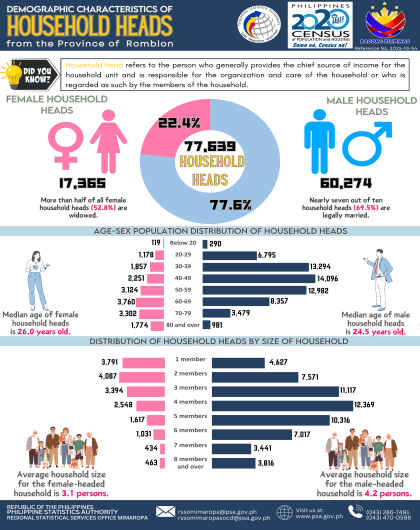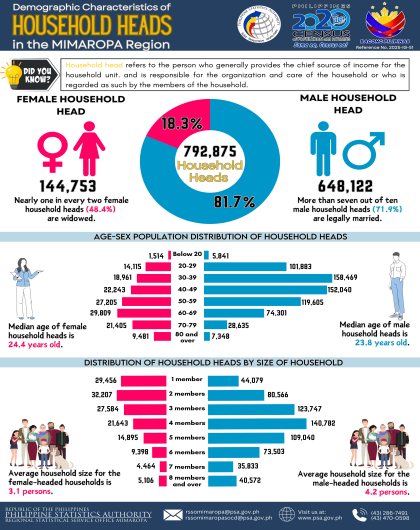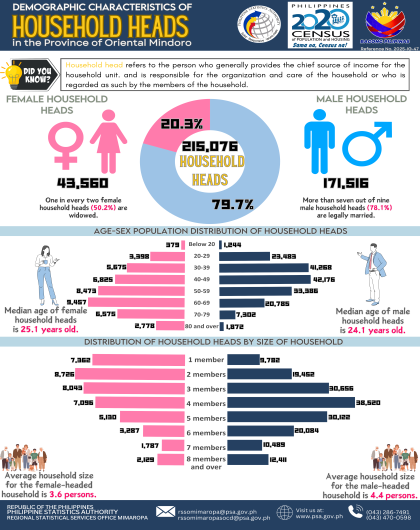Three in every 100 persons 15 years old and over from Oriental Mindoro’s household population are overseas workers
In 2020, about 19,296 persons or 3.1 percent of the Oriental Mindoro’s household population 15 years old and over were overseas workers. Moreover, a total of 2,810 persons or 17.0 percent were added from the reported 16,486 overseas workers reported in the 2015 Census of Population (2015 PopCen). (Figure 1 and Table A)
An overseas worker is one who is currently out of the country due to an overseas employment. He/she may or may not have a specific work contract or may be presently at home on vacation but has an existing overseas employment to return to.
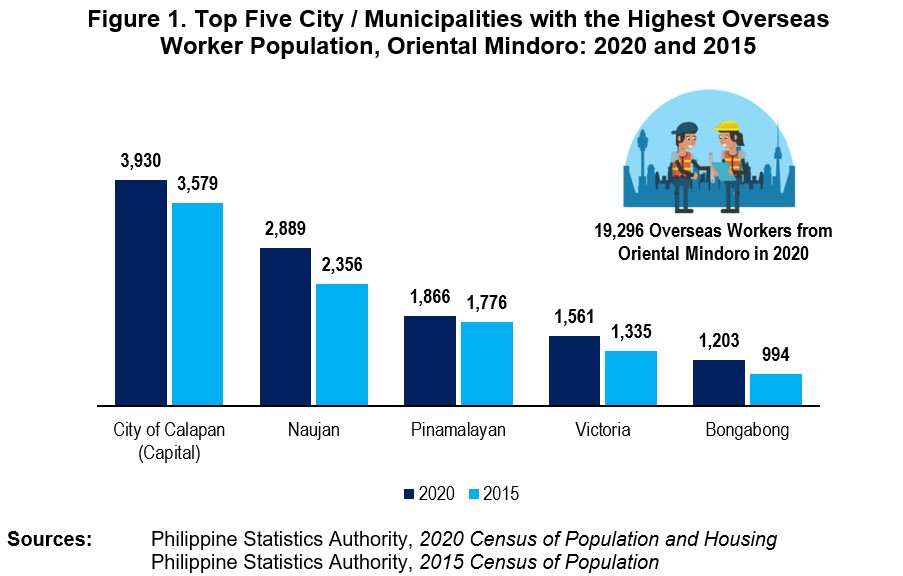
City of Calapan exhibits the highest number of overseas workers
Among the city/municipalities in the province, City of Calapan had the largest number of overseas workers at 3,930 persons. This accounts to a 20.4 percent of the total overseas workers in Oriental Mindoro. In addition, a sum of 351 persons or 9.8 percent were added to the 3,579 overseas workers coming from this city as reported in the 2015 PopCen. (Figure 1 and Table A)
Meanwhile, the municipality with the lowest number of overseas workers was San Teodoro at 268 persons. This corresponds to a 1.4 percent share of the provincial population of overseas workers. (Figure 1 and Table A)
Relative to the 2015 PopCen, the municipality of Naujan showed the highest increment in the number of overseas workers by 22.6 percents, while only the municipality of Pola exhibited a decline in the reported number of overseas workers by 10.8 percent. (Table A)
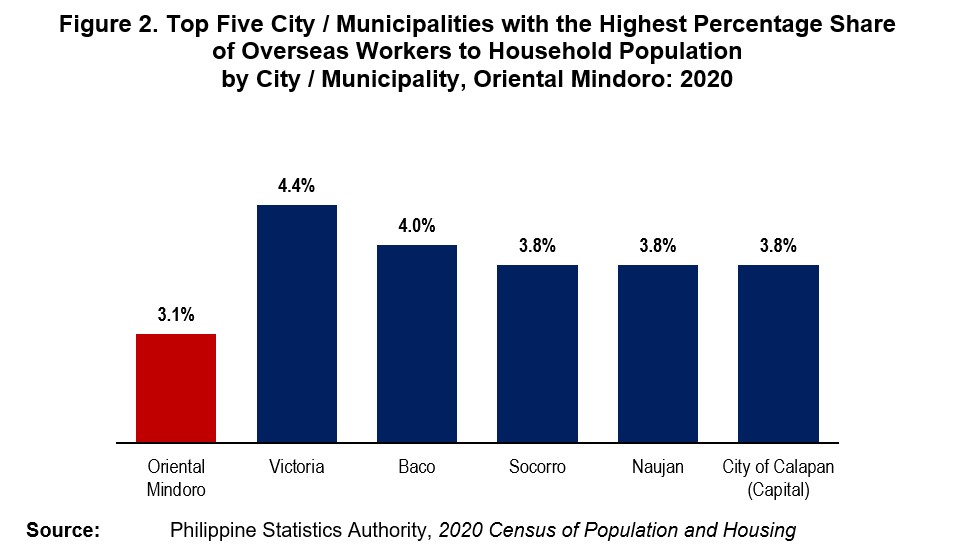
In 2020, overseas workers who originated from Oriental Mindoro was most prevalent in the municipality of Victoria relative to other city/municipalities in the province with 4.4 percent share to the municipalities’ household population 15 years old and over. This was followed by Baco with 4.0 percent of its household population comprised of overseas workers. Moreover, the city / municipalities that exceeded the provincial proportion of overseas workers were Socorro (3.8%), Naujan (3.8%), City of Calapan (3.8%), Gloria (3.4%), and Puerto Galera (3.3%). Meanwhile, the municipality of Bulalacao had the least proportion of overseas workers at 1.4 percent. (Figure 2 and Table A)
Sex ratio among overseas workers stands at 75 males per 100 females
Of the 19.2 thousand overseas workers from Oriental Mindoro, around
11.0 thousand (57.2%) were female while about 8.3 thousand (42.8%) were male. This translates to a sex ratio of 75 males for every 100 females. (Table 1)
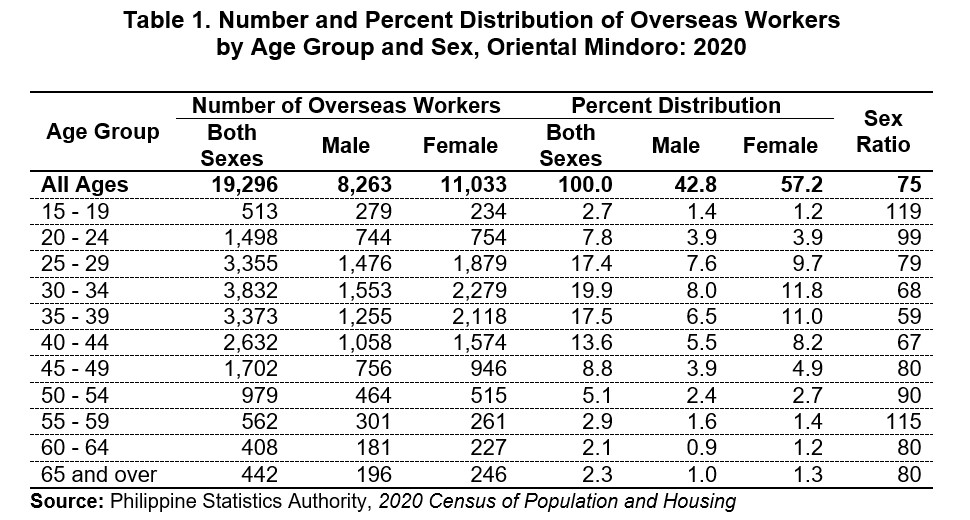
The highest representation of overseas workers in terms of age group falls between 30 to 34 years with a total of 3,832 persons or 19.9 percent of the total number of overseas workers from Oriental Mindoro. Other age groups with more than 10.0 percent share to the provincial number of overseas workers include 35 to 39 years with 3,373 persons (17.5%), 25 to 29 years with 3,355 persons (17.4%), and 40 to 44 years with 2,632 persons (13.6%). (Table 1)
Females outnumbered males for those overseas workers 20 to 54 years old and 60 and over from Oriental Mindoro. It can be noted that the sex ratio of these age groups ranges from 59 to 99 males per 100 females. On the other hand, males dominated females on those age groups 15 to 19 years old and 55 to 59 years old with sex ratio ranging of 119 and 115 males per 100 females, respectively. (Table 1)
More than half of overseas workers are legally married
Of the 19.3 thousand overseas workers from Oriental Mindoro, around 18.9 thousand persons or 50.1 percent were legally married. In addition, 5.2 thousand persons or 26.9 percent were never married. The rest of the total population of overseas workers was categorized as follows: in common-law or live-in marital arrangement (12.8%), divorced, separated or annulled (7.3%), and widowed (3.0%). (Figure 2 and Table B)
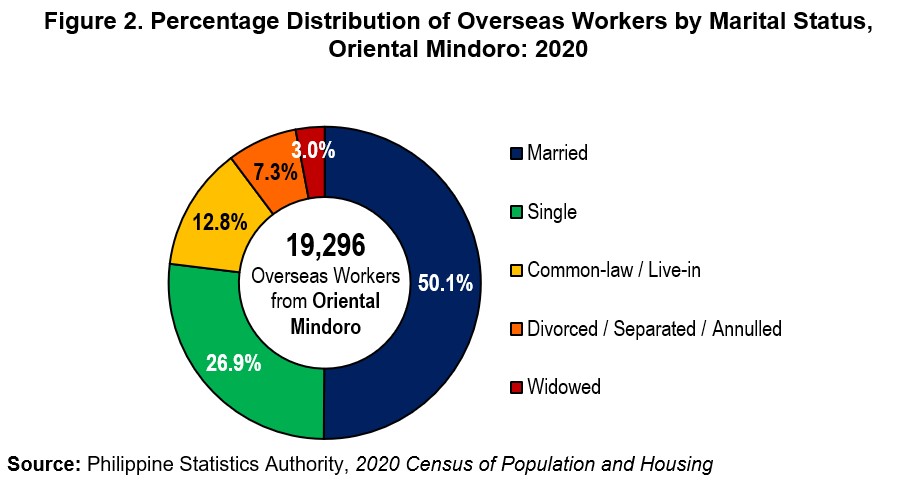
Almost all overseas workers are Non-Indigenous Peoples
Among 19.3 thousand overseas workers, nearly 19.0 thousand or 98.3 percent were classified as non-Indigenous Peoples. Of these, Tagalog had the largest share of 88.5 percent, and was followed by Bisaya / Binisaya (4.7%), Ilocano (2.9%), Romblomanon (1.1%), and Bikol / Bicol (0.9%). (Figure 3 and Table C-1)
Moreover, 210 overseas workers from the province or 1.1 percent belonged to ethnic groups solely identified by the National Commission on Indigenous People (NCIP) as Indigenous Peoples. More than one-third or 34.8 percent of these overseas workers were Mangyan-Hanunuo. Other major Indigenous Peoples groups as ethnicity of overseas workers originating from Oriental Mindoro include Mangyan-Tadyawan (10.0%), Mangyan-Buhid (8.1%), Mangyan-Alangan (6.7%), and Bantoanon (6.2%). (Figure 3 and Table C-2)
Majority of overseas workers are Filipino citizen
An estimate of 19.1 thousand overseas workers from Oriental Mindoro were Filipino citizens in 2020. This comprised 99.1 percent of all overseas workers from the region. Females outnumbered males with sex ratio of 74 male overseas workers per 100 female overseas workers. (Table 2 and Table D)
On the other hand, 115 overseas workers from the province had dual citizenship (0.6%) and 58 overseas workers who were foreign citizens (0.3%). Females had a larger share among overseas workers with dual citizenship at 50.4 percent. Meanwhile on overseas workers who were foreign citizens, males dominated females with a share of 89.7 percent. (Table 2 and Table D)
Among those overseas workers with dual citizenship from the region, 28 were Filipino-Italians (24.3%). In addition, other dominating citizenship were Filipino-Americans (22.6%), Filipino-Canadians (20.0%), Filipino-Germans (5.2%), and Filipino-Spanish (5.2%). (Table E-1)
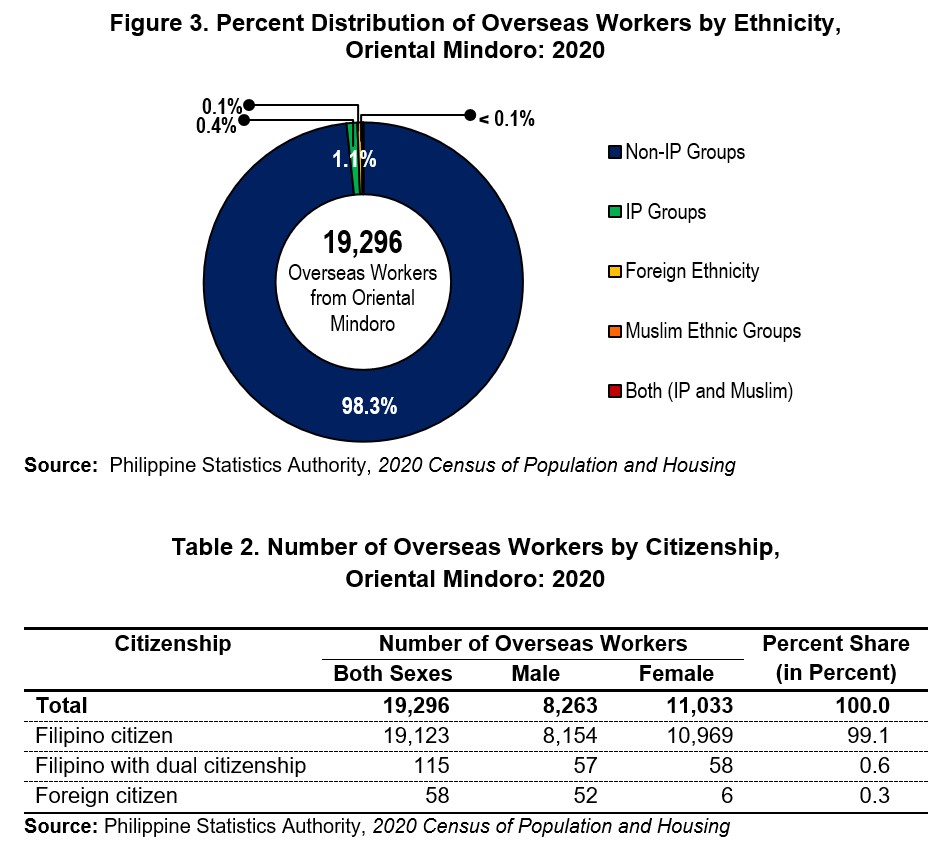
On the number of overseas workers from the region with foreign citizenship relative to the reference date and time of the census, those who are citizen of India and the United States of America were the highest with each having five persons (8.6%). It was followed by those who are citizens from Canada, Japan, and Viet Nam with four persons (6.9%) for each country. (Table E-2)
Roman Catholic dominates religious affiliation of overseas workers
Of the 19.3 thousand overseas workers from Oriental Mindoro, 84.6 percent or nearly about 16.3 thousand persons reported Roman Catholic as their religious affiliation. It was followed by Iglesia ni Cristo with 562 overseas workers (2.9%), Seventh Day Adventist with 275 overseas workers (1.4%), Church of Christ with 186 overseas workers (1.0%), and Jesus is Lord Church with 182 overseas workers (0.9%). (Table 3)
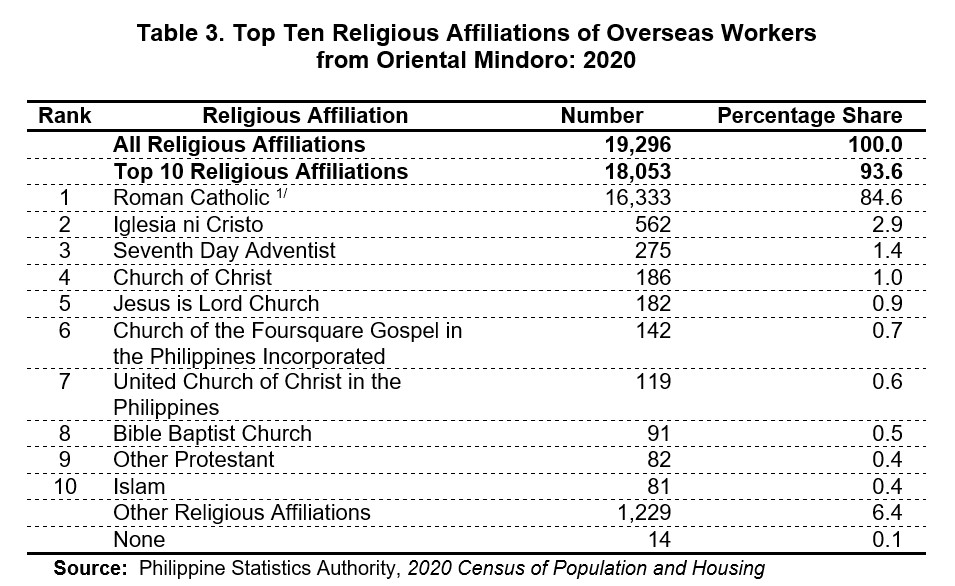
At least nine in every 20 overseas workers have reached college level
Among 19.3 thousand overseas workers, nearly 18.0 thousand persons or 45.7 percent had reached or completed college level (graduate: 32.2%, and undergraduate: 13.5%). This was followed by those overseas workers who reached or completed high school level at 7.7 thousand or 39.8 percent (graduate: 32.2%, and undergraduate: 7.6%), and short-cycle tertiary course at 1.5 thousand or 7.9 percent (graduate: 7.8%, and undergraduate: 0.1%). Furthermore, around 1.1 thousand overseas workers from the province or 5.7 percent attained or finished elementary level (graduate: 3.8%, and undergraduate: 1.9%). (Figure 4 and Table F)
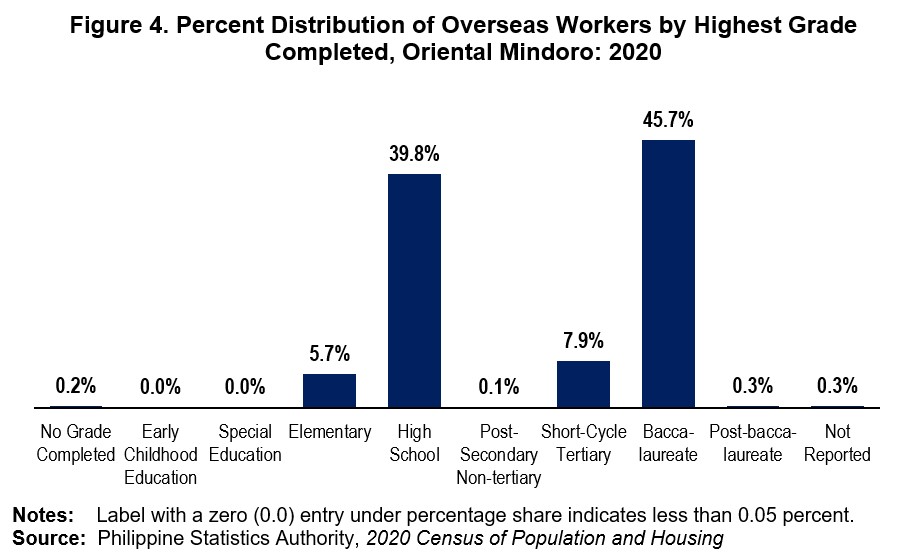
The statistics presented in this special release were based on the information provided by the respondent or any responsible member in the household who may provide accurate answers to the questions and give correct information about the household.
(SGD) LENI R. RIOFLORIDO
Regional Director
MLLM / OHG / RRL / MTYAD


